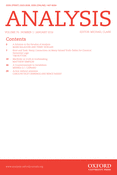-
Views
-
Cite
Cite
Serena Olsaretti, Born Free and Equal? A Philosophical Inquiry into the Nature of Discrimination By K. Lippert-Rasmussen, Analysis, Volume 76, Issue 1, January 2016, Pages 111–113, https://doi.org/10.1093/analys/anv063
Close - Share Icon Share
Extract
At the outset of Born Free and Equal?, Kasper Lippert-Rasmussen helpfully identifies the three central questions his book addresses: ‘What is discrimination?; What makes it wrong? and What should be done about wrongful discrimination?’ (3). To each of these questions Lippert-Rasmussen dedicates one of the three parts into which the book is divided.
According to Lippert-Rasmussen, discrimination is differential treatment (which includes acts, policies and practices) on the basis of real or imputed membership in socially salient groups (i.e. groups perceived membership of which structures interaction in many social contexts), which either shows a biased attitude towards those discriminated against (as in the case of direct discrimination), or which does or would result in the discriminatees’ being made worse off relative to others (as with some instances of direct discrimination, and as with indirect discrimination). Although there are other types of differential treatment, including some which are wrongful, Lippert-Rasmussen justifies focusing on group discrimination as defined above on the dual grounds that this is what is often at stake in debates on discrimination and that group discrimination is a reliable proxy for wrongful differential treatment (33).




